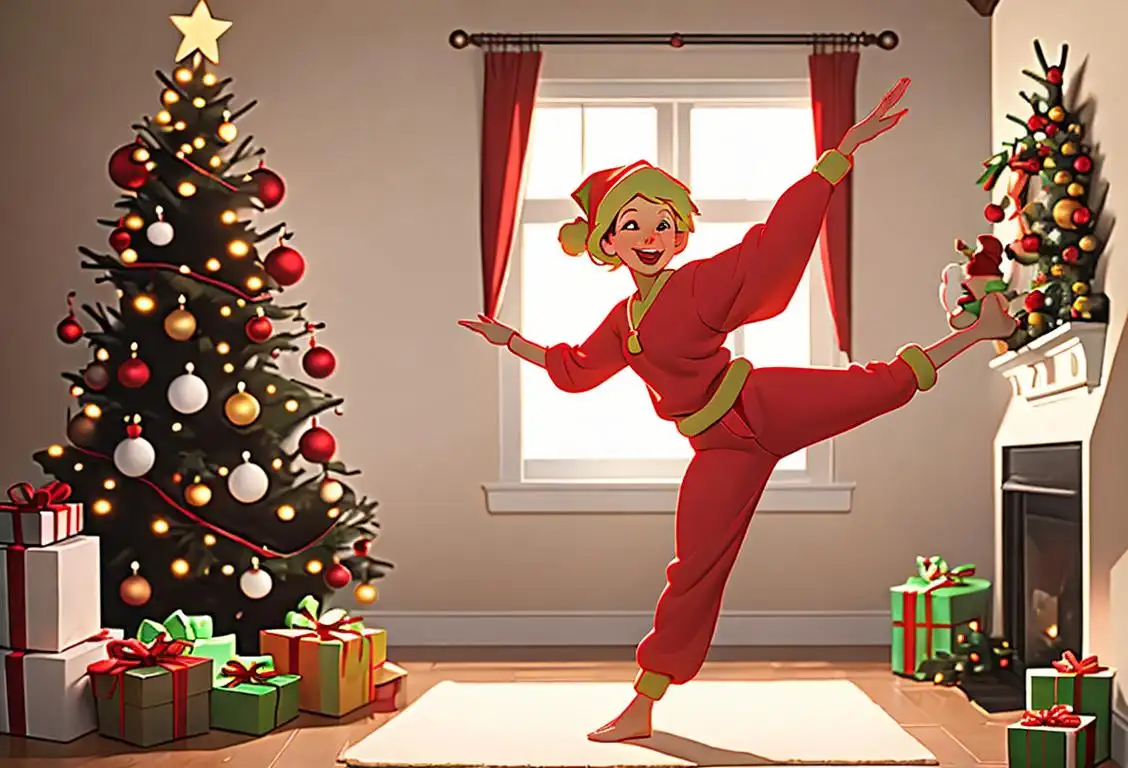National Taking Down Your Christmas Decorations Day

Happy National taking down your Christmas decorations Day! It's the perfect time to bid farewell to the holiday season and get your living space back to its normal, non-jingle bell state. Whether you've decked the halls with boughs of holly or hung enough lights to confuse the International Space Station, this day is dedicated to the bittersweet act of saying goodbye to all things merry and bright.
When is Taking Down Your Christmas Decorations Day?
It's national taking down your christmas decorations day on the 10th January.
The Internet's Holiday Obsession
Did you know that National taking down your Christmas decorations Day is quite a popular topic online? We found a whopping 177 mentions of it scattered across the vast expanse of the internet. It seems that people just can't resist discussing the joy and lamentation that comes with disassembling their festive trimmings.
The most mentions of this holiday were recorded on January 10, 2021. We're not entirely sure why that date specifically triggered an urge to pack up tinsel and ornaments, but perhaps it was a collective epiphany that attempting to extend the holiday season indefinitely might lead to a severe shortage of storage space.
Farewell, Tannenbaum!
As you bid farewell to your beloved Christmas tree, it's natural to feel a sense of nostalgia. After all, it has been standing tall, radiating holiday cheer for weeks. But fear not! There are ways to make the process of dismantling and storing your decorations a little less melancholic and a lot more efficient.
First, gather your loved ones for one last festive endeavor. Turn it into a fun family activity by reminiscing about your favorite holiday memories as you take down the garlands and untangle the strands of twinkling lights. Play some cheerful tunes in the background to keep the spirits high and the feet tapping.
Before you proceed, make sure to designate a specific area for organizing your decorations. This will make next year's decorating extravaganza a breeze! Categorize your baubles, wreaths, and Santa figurines into separate containers. Remember, no one wants to discover a forgotten piece of fruitcake underneath a tangled mess of festive décoration!
To reduce the chances of becoming victim to the perennial curse of the missing ornament, label your storage containers properly. A simple labeling system, such as 'Lights,' 'Tree Ornaments,' and 'Festive Tchotchkes,' can save you from hours of frustration next holiday season.
Once everything is neatly packed away, take a moment to step back and admire your clean, uncluttered living space. Admittedly, it may be missing a touch of the seasonal sparkle, but think of it as a blank canvas, primed and ready for new adventures and celebrations throughout the year.
Did You Know?
Did you know that some people leave their Christmas decorations up all year round? While it may seem a little eccentric, there are those who find joy in keeping a touch of holiday spirit alive every single day. So, if you're feeling a tad melancholy as you pack away your own decorations, just remember that there are others out there who refuse to let the twinkling lights go dim.
History behind the term 'Taking Down Your Christmas Decorations'
1840
The Victorian Era: Christmas Trees Become Popular
In the early 19th century, the royal family's publication of a woodcut illustration of Queen Victoria and Prince Albert celebrating around a Christmas tree sparked a new trend. This depiction of domestic bliss brought the idea of decorating Christmas trees into Victorian homes, mainly in England.
1605
The Origins of Christmas Decorations
The tradition of decorating homes during the Christmas season can be traced back to 1605 in Germany. Christians would bring evergreen trees into their homes and decorate them with fruits, nuts, and candles as a symbol of life and light during the dark winter months.
1605
The Early Origins
The practice of decorating homes during the Christmas season can be traced back to the early 17th century. In 1605, the first recorded instance of decorating trees for Christmas was mentioned in a diary written by a German traveler. He described how people in the Upper Rhineland region would put up fir trees in their homes and adorn them with flowers, fruits, nuts, and candles.
1700s
Origins of Christmas tree decorations
In the 1700s, the tradition of decorating evergreen trees during the winter holidays became popular in Europe. People would adorn their trees with candles, fruits, nuts, and sometimes even small toys.
1800
Introduction of the Christmas Tree
The tradition of taking down Christmas decorations can be traced back to the introduction of the Christmas tree in the early 1800s. During this time, German immigrants brought the custom of decorating an evergreen tree into their American homes. The tree, adorned with candles, fruits, and other ornaments, served as the centerpiece of the holiday celebration. At the end of the festive season, the tree would be taken down to avoid any potential fire hazards.
1840
The Victorian Influence
The tradition of taking down Christmas decorations gained prominence during the Victorian era in the 19th century. Queen Victoria and Prince Albert popularized the practice of decorating a grand Christmas tree at Windsor Castle. As news of their festive display spread, the idea of decorating trees became fashionable among the middle class. However, it wasn't until several decades later that the tradition of taking down decorations after the holiday season really took hold.
1880
Christmas Tree Disassembly
By the late 19th century, decorating Christmas trees had become widespread in America. The process of taking down the decorations involved disassembling the tree from top to bottom. The ornaments were carefully removed, starting with the delicate glass baubles and other fragile decorations. The candles, if used, were extinguished, and the tree was undecorated branch by branch.
1800s
Introduction of glass ornaments
By the 1800s, glassblowers in Germany began producing intricate glass ornaments specifically designed for Christmas tree decorations. These delicate and ornate ornaments added a touch of elegance to the festive tree.
1880
Brightening Up with Electric Lights
At the end of the 19th century, Thomas Edison's invention of electric lights provided a safer and more convenient alternative to candles. Eventually, people started using electric lights to adorn their Christmas trees, creating a colorful and brilliant display.
1848
The Advent of the Christmas Tree in Britain
In 1848, Queen Victoria and her German-born husband, Prince Albert, were depicted in the Illustrated London News standing around a decorated Christmas tree. This image popularized the Christmas tree tradition in Britain and eventually spread to other English-speaking countries, solidifying the use of Christmas decorations in homes.
1882
The First Electric Christmas Lights
The first electric Christmas lights were introduced in 1882 by Edward H. Johnson, an associate of Thomas Edison. He hand-wired 80 red, white, and blue electric light bulbs and displayed them on a Christmas tree in his New York City home. This innovation revolutionized the way people decorated their trees, making it safer and more convenient.
Late 1800s
Victorian influence
During the late 1800s, Queen Victoria's love for decorating Christmas trees with elaborate ornaments greatly influenced the practice. It became a trend among the upper class to have lavishly decorated Christmas trees in their homes.
1920
Tradition Solidified
In the early 20th century, the tradition of taking down Christmas decorations became more standardized. Many believed that it was bad luck to keep decorations up beyond the Twelfth Night, which falls on January 5th. The Twelfth Night marks the end of the Christmas season and the eve of the Epiphany. It is believed that if decorations were left up after this date, misfortune and bad luck would befall the household.
1920
The Advent of Tinsel
In the 1920s, tinsel became a popular decoration for Christmas trees. Originally made from real silver, tinsel added a sparkling touch to the tree. Over time, it transitioned to being made from various shiny materials, including plastic and metal.
1900
Boxing Day Tradition
In some countries, such as the United Kingdom, the day after Christmas, known as Boxing Day, became associated with taking down Christmas decorations. This tradition may have originated from the practice of servants receiving gifts or leftover food from their employers on Boxing Day. As servants would have been responsible for decorating their employers' homes, they would help dismantle the decorations as part of their duties.
Early 1900s
Spread to North America
As European immigrants brought their holiday traditions to North America, the practice of decorating Christmas trees with ornaments spread across the continent. It became a cherished custom among families to gather and decorate trees together.
1950
Artificial Trees Gain Popularity
With the desire for convenience and reusable decorations, the 1950s saw the rise of artificial Christmas trees. Made from materials like aluminum and plastic, these trees could be used year after year, reducing the need to cut down live trees.
1940
Superstitions and Folklore
Throughout history, various superstitions and folklore have influenced the timing of taking down Christmas decorations. In some cultures, it was believed that taking down decorations after the New Year would bring good luck for the coming year. Others believed that leaving them up beyond a certain date would invite evil spirits into the home. These beliefs varied from region to region and often led to different practices regarding when to take down the decorations.
20th Century
End of the Christmas Season
Over the course of the 20th century, the tradition of taking down Christmas decorations became more widespread and standardized across different cultures. The practice of dismantling the decorations typically occurs between the first week of January and the Epiphany, marking the end of the Christmas season. Many people follow the superstition that leaving decorations up past this time can bring bad luck for the rest of the year.
1945
Post-World War II Commercialization
After World War II, the commercialization of Christmas reached new heights. Companies began mass-producing ornaments and decorations, making them more affordable and accessible to the general public. This led to an increase in the number and variety of Christmas decorations that people would use to adorn their homes.
Present
Modern Practices
Today, the tradition of taking down Christmas decorations varies among individuals and cultures. While some prefer to take them down immediately after New Year's Day, others choose to leave them up until the end of January. Many factors influence these decisions, including personal preferences, cultural traditions, and convenience. Regardless of when the decorations come down, it marks the official end of the festive season and prepares the home for the year ahead.
1960
Ornaments Evolve and Expand
During the 1960s, the variety of Christmas ornaments expanded, reflecting the changing tastes and cultural influences of the era. Traditional glass baubles continued to be popular, while newer materials like plastic, fabric, and even edible ornaments, such as candy canes, gained popularity.
Late 20th Century
Extended Display Period
In the late 20th century, the practice of taking down Christmas decorations gradually shifted. While traditionally decorations were taken down on January 6th, known as Epiphany or Twelfth Night, many people started extending the display period well into January. Some even keep their decorations up until February, especially if they celebrate Candlemas, a Christian holiday occurring 40 days after Christmas.
Mid-1900s
Artificial trees and mass-produced ornaments
In the mid-1900s, artificial Christmas trees and mass-produced ornaments became readily available. This made it easier for more people to participate in the tradition of decorating their homes for the holiday season.
Present Day
Personal Preference
Today, the timeline for taking down Christmas decorations varies depending on personal preference and cultural traditions. While some people still adhere to the traditional dates, others may choose to remove decorations as early as New Year's Day or as late as the end of January. Ultimately, it is up to each individual or household to decide when to take down their Christmas decorations.
Present day
Taking down Christmas decorations
Taking down Christmas decorations became a common practice after the holiday season, typically in early January. It symbolizes the end of the festive period and the return to normalcy. Many believe that it is important to take down decorations before Twelfth Night, which falls on January 5th or 6th.
1990
The Popularity of Nativity Scenes
In the 1990s, more households began including nativity scenes as part of their Christmas decorations. Displaying miniature figurines representing the birth of Jesus became a symbolic way of honoring the religious significance of Christmas.
Present
The Tradition of Taking Down Christmas Decorations
As the holiday season concludes, it has become customary to take down Christmas decorations around the early days of January. While exact timing varies among cultures and individuals, removing the ornaments, lights, and trees marks the end of the festive season and prepares for the new year ahead.
Did you know?
Did you know that some people leave their Christmas decorations up all year round? Talk about having a holly jolly spirit 365 days a year!Tagged
fun loved ones propertyFirst identified
10th January 2021Most mentioned on
10th January 2021Total mentions
177Other days
Awareness Day
Seniors Day
One Day
Suicide Prevention Month Day
Opposite Day
Veterans Day
Tv On The Same Day
Action Day
Happiness Day
Family Day









